Services on Demand
Journal
Article
Indicators
-
 Cited by SciELO
Cited by SciELO -
 Access statistics
Access statistics
Related links
-
 Similars in
SciELO
Similars in
SciELO
Share
Revista Latinoamericana de Desarrollo Económico
Print version ISSN 2074-4706On-line version ISSN 2309-9038
rlde no.9 La Paz Oct. 2007
Pension Liabilities and Public Finances in Bolivia: Evidence from a Reformer Country
Jaime A. Garrón Bozo*
Abstract
In 1996 Bolivia undertook a radical pension reform, switching from an unfunded to a fully funded privately managed system. This paper analyzes the impact of the pension reform and post-reform pension policies (1997-2003) on public finances; it shows initial estimates for the transition cost, analyzes the main factors that increased the financial burden for the Treasury to unexpected levels, presents some public accounting considerations, and examines post-reform linkages between the Treasury and the new pension system. It concludes that the effect of the pension reform and post-reform pension policies on public finances has been two-fold: increasing considerably pension net liabilities, and inducing a higher fiscal deficit for the explicit report of the pension debt.
Resumen
En 1996 Bolivia llevo a cabo una reforma radical en pensiones, cambiando de un sistema de reparto a otro basado completamente en administración privada (capitalización individual). El presente documento analiza el impacto que sobre las finanzas públicas tuvo la política de reforma de pensiones y aquellas otras políticas aplicadas en el período postreforma (1997-2003). Se muestran estimaciones iniciales sobre el costo de transición, se analizan los factores principales que incrementaron la carga financiera del Tesoro a niveles inesperados, se presentan algunas consideraciones sobre la contabilidad pública, y también se examinan las relaciones en el período postreforma entre el Tesoro y el nuevo sistema de pensiones. Se concluye que el efecto sobre las finanzas públicas de la política de reforma de pensiones y postreforma tiene dos características: un aumento considerable de la carga neta en pensión, y que esta induce a un mayor déficit fiscal, de acuerdo a la deuda en pensiones reportada.
Introduction
Traditionally, social security pension systems were focused on providing financial security to old-aged population, based on intra-intergenerational redistribution and solidarity1. Initially, economists did not analyze the overall impact of the system on economic growth, capital and financial markets, and national savings. Nevertheless, since the economic crisis of the 80's in emerging economies -particularly Latin America-variables such as economic growth, national savings, labor markets and employment, have been linked with causality to the pension system (Mesa-Lago, 2001, 2004).
There are two main paradigms in social security pensions in terms of financing and administration: the collective partial capitalization and pay-as-you-go (PAYGO) systems -usually administered by autonomous public institutions, and the fully funded (FF) system of individual accounts -which is usually administered by private corporations.
In general, PAYGO systems in developing countries have shown: (i) weak contribution-benefit links, leading to poor affiliation incentives; (ii) failure to face population ageing due to the lack of long-run financial sustainability; (iii) incentives for current affiliates to avoid contributions, implying increasing governmental subsidies; and (iv) state and political interference.
The implementation of a FF system, in contrast, is supposed to: (i) introduce strong incentives for affiliation and payment, given the explicit link between contribution and benefits; (ii) provide financial stability against demographic risks; (iii) contribute to the development of capital markets and boost national savings, and (iv) immunity concerning state and political intervention. Some of these beneficial effects, however, have not taken place after reforming the pension system, as Mesa-Lago y Bertranou (1998) suggests using evidence from Latin America. Among disadvantage of a FF system that are often cited are: (i) transmission of risks from the government to individuals2, and (ii) null income redistribution effects3 (World Bank, 1994; Barrientos, 1998; Mesa-Lago, 2004).
Following the so-called Latin American model, Bolivia undertook, in 1996, a radical structural pension reform, completely switching from a publicly run unfunded system to a privately managed fully funded scheme. The reform was followed by the introduction of several pension policies that originated pension outlays to increase and generated an immediate fiscal imbalance, which has surpassed initial projection. This outcome is mainly due to increases in post-reform pension levels, introduction of new liabilities, and loosening of retirement requirements. Additionally, this new pensions scenario has created a trade-off between the fiscal cost for the Treasury and the rate of return of the new system, given financial linkages, ending up in a sum-zero-game.
This paper analyzes the impact of the pension reform and post-reform pension policies (1997-2003) on public finances in Bolivia. It provides an explanation of why this reform process led to increases in pension outlays, which jeopardizes fiscal sustainability and introduces distortions into the performance of the new pension system.
The paper has six sections. Section 1 examines the structure and deficiencies of the pension system prior to the reform. Section II describes the reform process and depicts the main features of the former PAYGO system and the new individual capitalization system. Section III summarizes initial projections and actual results of the fiscal cost. This review does not intend to compare in detail initial projections with actual results -given differences in initial assumptions for each projection-, but aims to highlight aggregate differences. Section IV presents a qualitative and quantitative analysis of the transition cost providing a detailed description of all components of post-reform pension expenditures, explaining to which extend such outlays were expected or not. Section V assesses the effect on public finances, in terms of pre and post-reform expenditure levels, fiscal accounting considerations, and financial linkages between the Treasury and the new pension system. Conclusions are presented in Section VI.
1. Background: Social Security Pensions Prior to the Reform
The pension system in Bolivia was introduced in 1956, and contemplated a mandatory first pillar4, with defined benefits, financed by employer, employee, and government contributions under an unfunded PAYGO system5. It had two components: a basic pension fund and 28 supplementary funds6. Additionally, there were other separate social security pension schemes, such as the military, private and public banking, the public university system, and the judicial system7.
The basic pension fund was in charge of the administration, collection of contributions, and payment of pensions for all affiliates in the public sector, while the supplementary funds were private institutions managed by trade unions but supervised by the government with the same functions as the basic fund, as an attempt to increase pension levels. By law, the pension was set using a replacement rate of 70% over the base salary: 40% financed by the basic pension fund and 30% by supplementary funds.
In the case of Bolivia, there were several factors than contributed to the worsening of the financial situation of the PAYGO system, compromising its sustainability. First and foremost, the ratio of active workers to one pensioner showed a steady decreasing trend down to 2.7 to 1 in 1995. Second, there were economic policy decisions and macroeconomic outcomes that eroded the pension reserves, such as in the case of the "dedollarization" policy of 19828, the hyperinflation period of 1984-1985, as well as political manipulation of the funds along with corrupt practices. Third, the two-year average salary basis for calculating the pension benefit introduced incentives to underreport salary levels prior to this period. Fourth, given the small coverage of the system (12 % in 1997), the existence of more than 30 administrative institutions led to an inefficient management and high administrative costs. Fifth, given the absence of direct links between contributions and pensions, the former were perceived as direct taxation leading to evasion. Sixth, financial arrears of public and private entities, because of unpaid contributions, also contributed to the financial collapse (Vargas del Carpio, 1996; Larrazabal and De la Barra, 1997; von Gersdorff, 1997, and Mercado, 1998).
2. The Reform and the New Private System
The reform was conceived as part of the structural transformation process that begun in the mid 1980's. After introducing a very successful stabilization plan in August of 1985, Bolivia followed -along with other Latin American countries- the guidelines of the so-called "Washington Consensus" (see Williamson, 1990). After macroeconomic stabilization, structural reforms were next. First and second generation reforms were introduced placing an active role for the private sector and setting the framework for a market-oriented economy (see Antelo, 2000). As essential part of the second-generation reforms, the pension reform strengthened the growing economic role of the private sector, granting the administration of the new pension system to international financial corporations, forming the so-called Pension Fund Administrators or AFP's (following their Spanish acronym).
The first attempts to reform the pension system in Bolivia were made during President Paz Zamora's administration (1989-1993), when in 1992, the Ministry of Finance prepared a proposal to reform the pension system -following the model adopted by Chile- with financial assistance from the United States Agency for International Development (USAID) and the World Bank (Gray-Molina et al., 1999). In the following years there were additional governmental and non-governmental studies of the pension system that suggested the need for structural change.
After several unsuccessful attempts of non-structural reforms, mainly due to small political support and intra-government conflict of interests, the reform was delayed and took place in 1996 under President Sanchez de Lozada's administration (1993-1997), when the Pension Law No. 1732 was passed by the Bolivian Congress9.
Effective since May 1, 1997, the reform completely substituted the PAYGO system by a mandatory second pillar, with defined contributions, entirely financed with employee contributions under a fully funded system (FF) of individual capitalization. The government acquired 100% of assets and liabilities of the closed system, and all insured workers were obligated to transfer to the new system. The new system was expected to achieve financial self-sustainability, expand coverage of the economic active population, increase national savings, help develop a capital market, and reduce labor market distortions. Tables 1 and 2 present a brief description of the former PAYGO system as well as the new fully funded scheme.
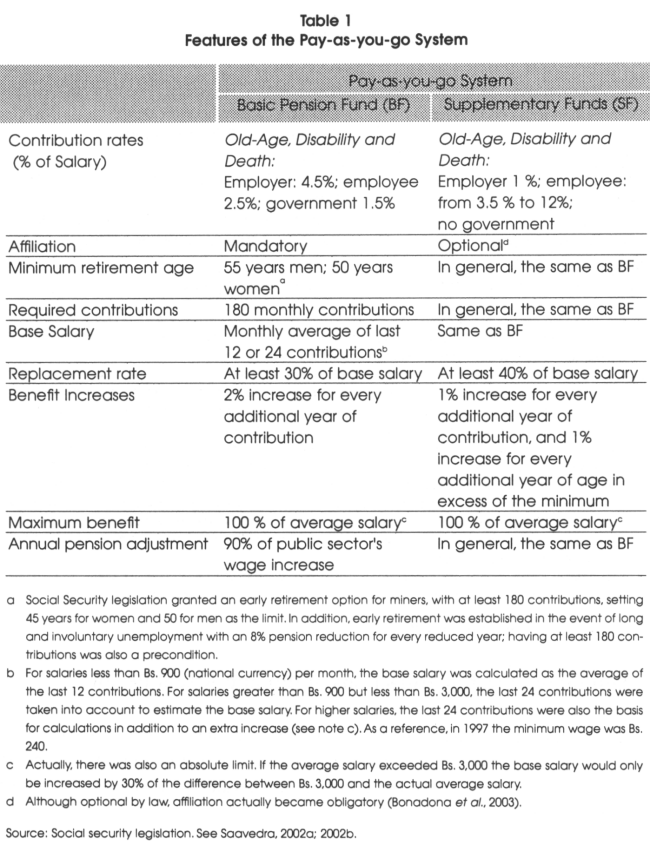
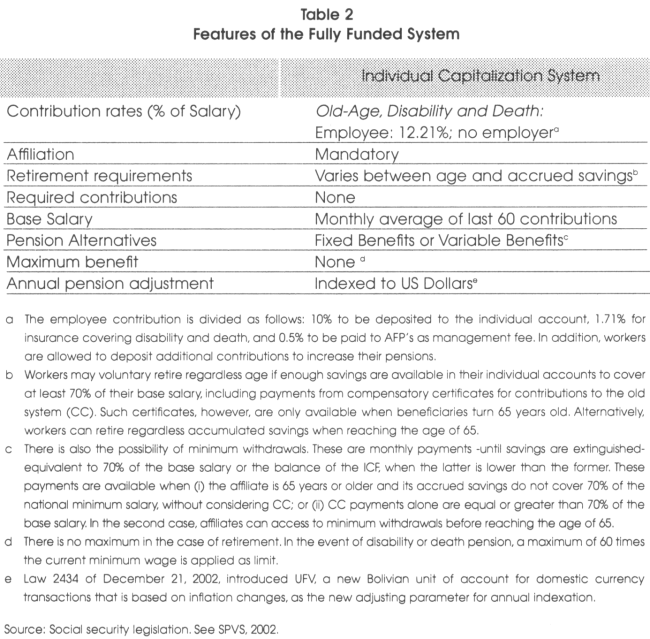
Financing the transition phase -until all liabilities of the old system are extinguished-becomes the major challenge for the sustainability of any reform, especially with the radical change implemented in Bolivia. During this period, the government is committed to repay all ongoing and entitled rights to pensioners acquired prior to the reform, but there are no longer contributions from insured workers to support such pension outlays. Usually, governments contract new debt to finance the transition'0. Hence, the transition cost is the result of making explicit all financial obligations previously acquired: the implicit pension debt (IPD).
3. Summary of Initial Projections of IPD and Actual Results
This section presents a summary of initial projections and actual results of the fiscal cost. It presents seven projections, including pre and post-reform estimates, in order to establish a general overview of initial expectations regarding the reform, confronted with actual results.
It is important to clarify some concepts for a better understanding of the data. Under a reform scenario, IPD refers to the accrued-to-date liabilities valuation equal to the net present value of pensions to be paid in the future based on accrued benefits; future contributions, or the accrual of new benefits linked to these contributions are not incorporated. In the case of a no-reform scenario, the IPD refers to an open-system liabilities valuation, where contributions and pensions of new workers under current rules are included (see Franco, 1995). The fiscal cost of the transition refers to the total amount of pension-related expenditures covered by the government after the reform.
3.1 Initial Projections
Mercado (1991) estimated the IPD under a no-reform scenario, for 1990-2000. The figures, estimated at 1989 prices, responded to a broadly financial-flow projection assuming a 3 % affiliation growth rate to the system, and unchanged contribution rates effective at 1990. The IPD, with 10% as discount rate, was estimated to be US$ 110 million. The average annual deficit of the pension system for 1991 -1995 was calculated to be 3.1 % of Gross Domestic Product (GDP). It was then proposed a structural reform introducing a fully funded pension scheme, but the report did not show a 10-year projection of the fiscal cost and only mentioned the possibility that the Bolivian government received foreign structural adjustment credits, if it decided to privatize the system.
Mackenzie et al (1993), from the International Monetary Fund, prepared a report on pension reform in Bolivia, using a model from UDAPE as the baseline for their projections, for 1993-202011. Among the main assumptions were: (i) a constant 5.1 % real GDP growth rate; (ii) a 10-year increase in the retirement age for men and women; (iii) a 5-year transition period to the new system; (iv) issue of recognition bonds for past contributions to the old system with a 7% nominal return in foreign currency; (v) a minimum pension subsidy under the new system; (vi) a 3% annual mortality rate among pensioners; and (vii) 0.9% rate of annual indexation for pensions. It also included debt service payments for projected financing requirements of the transition. The proposed reform excluded especial regimes such as the military, banking, and the public university system.
The report estimated that the unreformed system would had confronted an unsustainable deficit increase from 0.42% in 1993 to 3.37% of GDP in 2020. Reforming the system implied a three-time increase in pension outlays in the short term from 0.67% to 2.98% of GDP in 1993-2000. Following 2000, the cost would decrease steadily, so by 2010, the reform would be less costly for the Treasury in comparison to the no-reform scenario. Given these figures, the reform was presented as an attractive alternative.
Gamboa and Humerez (1997) elaborated the accounting model used as the governmental baseline to assess the fiscal cost for the transition for 1997-2060, including the basic and supplementary funds, but excluding the military pension fund. Among the major assumptions were: (i) 5.5% real GDP annual average growth rate for 1997-2020, and 4.7 % afterwards; (ii) retirement age at 65 years under the old and new systems, implying a ten-year increase for men and fifteen for women; (iii) international inflation rate around 2.5% for 1997-2003 and 2% for 2004-2060, (iv) no variation in pension levels -the projection was made in real terms (1996 dollars)-, and (v) a 3.1 % annual mortality rate among pensioners (see Grandi, 2001).
The IPD for 1997-2060 under the no-reform scenario was calculated to be US$ 3.4 billion (46 % of GDP) with a 6.9 % discount rate, at 1 996 dollars. On the other hand, the IPD of the reformed system was estimated to be US$ 2.4 billion (32% of GDP). Therefore, the reform was meant to generate savings for the Treasury of approximately US$ 1 billion in IPD.
The deficit of the pension system under a no-reform scenario was estimated to steadily increase from 0.63% of GDP in 1997, up to 3 % in 2060. Under a reformed system, the deficit would follow a steady decline from a maximum of 2.9% in terms of GDP in 1 997, down to zero by 2060. Starting 2017, the reformed system would become less costly for the Treasury in comparison to the no-reform scenario. Considering this outcome, the government implemented the pension reform.12
Larrazabal and De la Barra (1997) estimated the fiscal cost for the pension reform for 1997-2057, including: (i) the basic and supplementary funds; (ii) compensatory payments for contributions to the old system starting in 1997; (iii) the compensatory salary increase for higher post-reform contribution rates; (iv) debt service payments of public borrowing (8% in US dollars) required to finance the transition, and (v) mortality rate within pensioners of 2%. It did not include the military pension fund.
The IPD, in nominal dollars and using an 8 % discount rate, was estimated to be US$ 5.3 billion (67% of GDP). As percentage of GDP, the model projected an increasing deficit from 3% in 1997 up to 5% in 2020, followed by a declining trend.
Von Gersdorff (1 997), from the World Bank, estimated the fiscal cost for 1997-2037 including the basic and supplementary funds, but it is not clear whether it included the military pension fund or not. No details were available regarding macroeconomic and demographic assumptions. According to this projection, the highest level of deficit in the pension system of 2.72% of GDP would had been reached in 1998, followed by a declining trend. By 2037, PAYGO liabilities would be very low, demanding only 0.18% of GDP.
Zviniene and Packard (2002), also from the World Bank, elaborated a simulation analysis for 2001-2050, of the fiscal and equity outcome of pension reforms in eight Latin American countries -including Bolivia- applying the World Bank's Pension Reform Options Simulation Toolkit (PROST). Among the major assumptions were: (i) 3% real GDP annual average growth rate; (ii) zero inflation rate, and (iii) pension indexation linked to nominal wage growth. The estimation did not include compensatory payments for contributions to the old system, and the authors mistakenly included Bonosol outlays as a pension cost13. The number of beneficiaries, wage distribution of contributors, and other features effective in 2001, were used to project the counterfactual scenario, applying parameters of the old system.
According to this simulation, under a no-reform scenario, the pension system would had reached a 0.8% surplus in 2001, in terms of GDP, but followed by an unsustainable deterioration in its finances, implying increasing deficits up to 8.5% in 2050. As for the reformed system, the initial deficit of 3.5% of GDP was projected to decrease down to 0.9% by 2050. The IPD for 2001-2051 was estimated to be 108% of GDP under a no-reform scenario, and 50.8% under the reformed system, using 5% as discount rate.
Fernandez (2003), under the sponsorship of the Inter American Development Bank, estimated the IPD for 2003-2051, introducing unexpected pension policies that took place after the reform, which increased the fiscal cost. Although the model provides the most precise estimation available regarding the transition cost, there are still a few elements to be improved in terms of data quality, as Fernandez suggests, such as the case of the military pension fund and accrued rights of new retirees.
As of June 2004, final results are not published yet. However, preliminary estimates show an IPD for 2003-2051 of US$ 4.9 billion (63% of GDP), with 5% as discount rate. The fiscal cost was estimated to be 4.14% of GDP, on average, in 2003-2010, 2.56% in 2011-2030, and 0.44% in 2030-2051, excluding debt service payments of public borrowing required to finance the transition.
When reforming a pension system, initial and reform-induced IPD estimates provide analytical tools to establish the extent to which the reform will improve the long-run sustainability of the system. This section has presented a review of seven projections for the pension reform in Bolivia. Table 3 presents a summary of these projections, although a quantitative comparison among them is not possible given different underlying assumptions and projection periods.
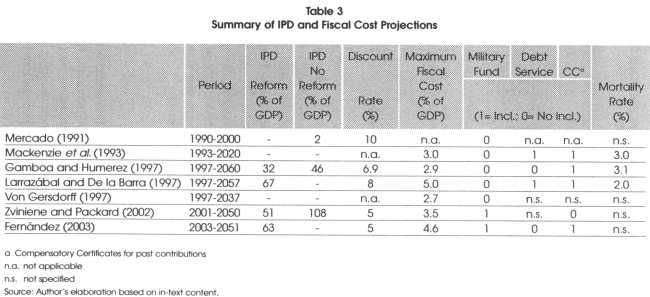
3.2 Actual Results
The fiscal cost of the transition turned out to be unexpectedly high as opposed to initial estimates14. Including debt service payments of Treasury Bonds (TB's) mandatory held by AFP's, pension costs have been increasing steadily since the implementation of the reform.
Table 4 shows the actual cost compared to an standardized version of applicable fiscal cost projections. As observed, the actual fiscal cost rose steadily from 3.1 % of GDP in 1997, up to 5.3% in 2003, being 4.3% the annual average for 1997-2003, as opposed to previous estimations: 2.3% by von Gersdorff, 2.6% by Gamboa and Humerez and Mackenzie et al, and 3.4% by Larrazabal and De la Barra. The difference between initial projections and actual results is mainly due to unexpected developments, including the inclusion of the military pension system in the reform, the sudden increase in retirement cases under the old system, the introduction of a minimum pension subsidy, and the change in the pension indexation parameter. These and other factors are discussed in detail in Section IV.
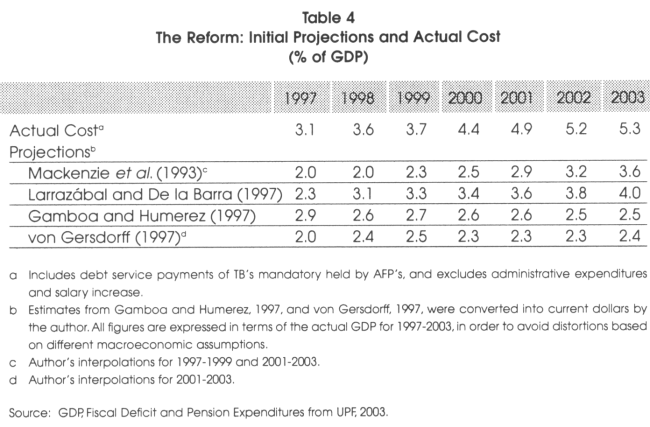
4. Analysis of the Transition Cost
The analysis of the transition cost will follow the categorization of Mesa-Lago (2000), separating external and internal factors. External factors are: (1) population ageing; (2) system maturity, and (3) level of coverage. Internal factors are: (1) Government liabilities after the reform; (2) eligibility criteria for retirement under the old system, and (3) post-reform contribution rates. The monetary valuation of the transition cost is shown at the end of the section.
4.1 External Factors
a. Population Ageing
Certainly, demography will affect the financial sustainability of a PAYGO system and will play a determinant role when introducing a structural reform. Bolivia has a young population: 37.5% is under the age of 15, the working population accounts for 56.1 %, and only 6.4% is the population over 60 years old; the median age is 20 years. During the last 25 years, the old age dependency ratio has remained around 1 2 % (INE, 2003). Nevertheless, population ageing will be seen in the next decades15.
Demographic factors, therefore, have lowered the financial burden of the transition. The population structure of insured workers has prevented the transition cost to be higher, as opposed to more aged populations, such as those in Argentina, Chile and Uruguay16. In 1994, 60.2% of PAYGO affiliates in Bolivia were between the ages of 15-39, 25% were between 40 and 49, and 15% were 50 years or older (Grandi, 2001). These figures have implied lower public transfers to a relatively low number of pensioners, longer periods to reach retirement ages, and a smaller compensation for past contributions to the old system. The first pensioners under the new system took place five years after the reform, in June 2002, and on December 31, 2003, there were only 425 pensioners under old age insurance (SPVS, 2003)17.
b. System Maturity
The Bolivian pension system was relatively young at the time of the reform, with a basic fund created in 1956 and the first supplementary fund in 1967; the direct consequence was a lower 1PD. On the contrary, other Latin American countries that undertook reforms had much older programs such as Uruguay, Chile and Argentina, with pension systems between 67 and 80 years old, implying greater pension liabilities (Mesa-Lago, 2000).
c. Coverage
A major deficiency of the old system was its low coverage, one of the lowest in Latin America, where coverage were as high as 60% to 80% in Uruguay, Chile and Argentina (Mesa-Lago, 2000). Bolivia's coverage of the working population in 1991-1994, was between 10.3% and 11.2%, reaching 12 % by the time of the reform (Escobar, 2003). This low coverage, that might have caused financial shortfalls to the old system, actually prevented a higher fiscal cost once the reform was implemented, limiting the size of liabilities that were covered by the government.
4.2 Internal Factors
a. Post-Reform. Government Liabilities
There are mainly four different aspects regarding post-reform government liabilities. First, the complete closure of the PAYGO system and 100% transfer of all insured to the new system as well as total absorption of military and supplementary pension funds liabilities, caused the IPD to become explicit, and created an immediate operational deficit of the pension system. Second, the government guaranteed and issued compensatory certificates for contributions to the old system (similar to Chile's recognition bonds). Third, the government introduced a minimum benefit for pensioners of the old system. Fourth, the reform changed the pension indexation mechanism from a previous 90% adjustment relative to the annual public sector wage increase, to the exchange rate variation of the Boliviano against the US dollar. These four aspects of post-reform government liabilities are discusses below.
Inclusion of Supplementary and Military Pension Funds
Although expected to become a public liability in all pre-reform projections, the absorption of all supplementary funds generated an additional burden for the Treasury, because prior to the reform the government was not responsible for liabilities regarding such funds. The case of the military fund was unexpected and a last moment decision when the government agreed to finance completely their pension, including a replacement rate of 100%18. After the reform, the military pension system was integrated into the new system.
Compensation of Contributions
Certificates were issued to compensate for past contributions to the old system, establishing the amount that the government is committed to transfer to the AFP at the time of the insured retirement, in order to co-finance the pension. According to law, all individuals that have more than 60 monthly contributions to the old system are entitled to a compensatory certificate (CC) involving monthly payments upon retirement; the amount of the certificate cannot exceed 20 times the national minimum wage. On the other hand, individuals who have less than 60 contributions are only entitled to receive a one-time payment, which also cannot exceed 20 times the national minimum wage19.
The law established a 2.8% replacement rate over the salary for each year of contribution, to estimate the value of the certificates20. It also established a 2 % increase over such salary for every 12 additional months without claiming the compensatory payment after reaching the age of 65.
The issue of certificates has lowered the post-reform financial burden for the Treasury, in terms of cash flow requirements, spreading costs over time at no financial cost -it does not provide any return or interest payments- as opposed to other Latin American countries such as Chile, Colombia, and Dominican Republic where an annual interest of 4%, 3% and 2% is granted, respectively (Mesa-Lago, 2004).
According to Fernandez (2003), 400,957 workers are entitled to claim certificates. In 2003, there were 425 pensioners (0.11 % of those eligible) under the new system: 56% of them financed entirely by certificates, 40% by certificates plus a fixed benefit paid by private insurance companies, and 4% financed by certificates plus a variable benefit paid by AFP's (SPVS, 2003).
Minimum Pension
The reform did not originally include a minimum pension. However, following pressures from pensioners, in November 2000, the government introduced a minimum pension of Bs.$ 550 (US$ 83). Another increase took place in May 2001, setting a new minimum of Bs.$ 850 (US$ 128)21. The latter increase in the minimum pension is financed in two different ways: one part -a new fiscal cost- comprises a Bs.$ 148 (US$ 22) bonus, while the other part (the indexation) -not an additional cost- is paid according to the pension level (the higher the pension the lower the increase)22.
Initially, these outlays were intended to cover the difference between the actual pension and the set minimum pension; hence, the subsidy would decrease as the pension increases. In practice, however, they were added to the pension (Grandi, 2001). Consequently, the resulting minimum pension in 2002 was Bs. 940 (US$ 131) as opposed to the minimum wage of Bs. 440 (US$ 61), implying a minimum pension more than twice the minimum wage. As Table 5 shows, by affecting about 54% of the pensioner's population, these agreements have become an additional burden for the Treasury23.
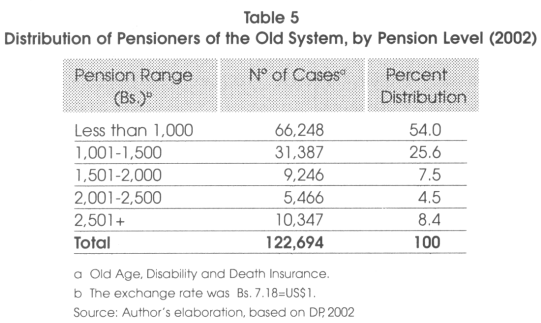
Indexation Mechanism
The post-reform indexation formula for pension benefits also had a negative effect on fiscal accounts. Prior to the reform, annual adjustments for pensions were indexed 90% to the public sector wage increase, which is based on inflation. The reform introduced a new indexation mechanism based on the annual average exchange rate variation of domestic currency (Bs.) against US dollars.
As Table 6 shows, the transition cost has been affected also by the trend of the exchange rate compared to former indexation mechanisms. Post and pre-reform indexation rates showed an increasing differential of up to 4.9 percentage points in 2003, raising the IPD of the transition, since all future adjustment -disregarding the rate-will be made on a higher basis.
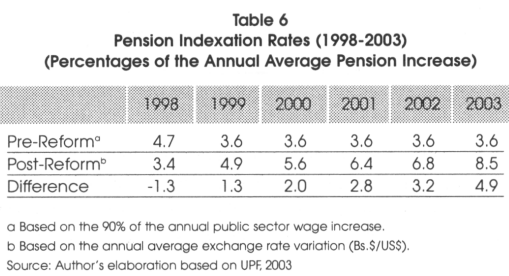
The behavior of the exchange rate, however, has been influenced by exogenous factors in the post-reform period, turning this variable into a random incremental fiscal cost. Within governmental macroeconomic assumptions, it was expected an inflation rate higher than the exchange rate depreciation for 1997-2060 (see Grandi, 2001). In fact, prior to the reform, inflation showed higher levels in comparison to depreciation. Graph 1 shows the trend for inflation and depreciation rates for 1991-2002.
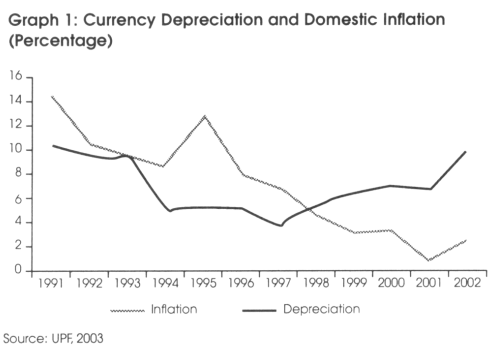
As observed, inflation and exchange rate depreciation trends, before and after the reform, were opposite. However, this outcome was very difficult to anticipate given that three major crises affected the exchange rate: the Asian in 1997, the Brazilian in 1999, and the Argentinean in 2002. Consequently, a new indexation mechanism was introduced.
Law 2434 of December 2002, introduced UFV (Unidad de Fomento a la Vivienda) as a new unit of account for local currency transactions with maintenance of value, and established its annual variation as the new adjustment factor for pensions. Following negotiation between government and pensioners, it was agreed that this provision would apply starting 2004.
b. Eligibility Criteria for Retirement under the Old System
The Pension Law set May 1, 1997, as the cutoff date for rights recognition under the old system. All insured to the basic and supplementary funds complying with retirement requirements by this date -55 years old if men and 50 years old if women, and at least 180 contributions- qualified for retirement under former PAYGO regulations24. All other insured were mandatory transferred to the new system.
Initially, for those who decided not to retire under the old system -having complied with all requirements-, the law established a 2% pension increase for every 12 additional contributions to the new system, allowing the possibility to reduce cash flow requirement for the Treasury in the short run25.
Certainly, not all insured fitted well into the government's transfer and retirement criteria. There were those who having complied with age requirements did not have 180 contributions. On the other hand, others did have 180 contributions but did not comply with age requirements. In the first case, there were established one-time payments, called Global Payments, releasing the government from any further liability. The second case, the so-called "sandwich generation", comprises approximately 9,000 people and refer to those who -unable to retire under the old system- have to contribute to the new system to reach the 70% replacement rate -over a different base salary- or wait to turn 65 years old. In this case, the lack of employment opportunities became the bottleneck of the problem.
Unexpected Early Retirement
Early retirement decisions became a big concern for the government and its short-run financing requirements. At the time of the reform, the government estimated that 26,242 additional insured would qualify for retirement under the old system, without considering the military. However, this process was expected to be gradual, spread during 12 years, thus, limiting cash flow requirements (Grandi, 2001). Actual figures, however, have been higher than expected. In 1997-2002, there were 36,725 additional pensioners, and a last cohort of 19,594 pensioners is expected for the following years (SENASIR, 2003).
Almost all pre-reform projections assumed that the retirement age under the old system would be 65 years old, but such an increase was not included in the pension draft law26. The latter, however, did increase the number of contributions from 180 to 300, implying 10 additional years of contributions. Yet, the final version passed by Congress did not include such modification, but maintained 180 contributions as well as the explicit requirement of 55 years for men and 50 for woman. This decision reduced the probability of greater social conflict27.
President Banzer's Administration (1997-2002) established a deadline for submitting retirement applications for pensions under the old system for all affiliates fulfilling requirements by the cutoff date, and issued regulations introducing incentives for early retirement:
a) Initially, May 1, 1999, was set as deadline, but then it was extended to December 31, 2001; following this date, all affiliates would only have the option of retirement under the new system. The impact of this provision was critical in terms of retirement decisions given the great level of uncertainty, at that time, regarding compensatory payments for past contributions, probably leading to anticipated retirement decisions. Later, it was established the possibility to submit retirement applications but delay the pension claim until December 31, 2003 -allowing affiliates to keep working until this date- as an attempt by the government to cease early retirement (Grandi, 2001). In the case of the military pension fund, the cutoff date was established at December 31, 2002, and the deadline for submitting retirement applications was set at December 31, 200328;
b) There were extended early retirement options to all affiliates; men and women were allowed pension benefits 5 years before reaching the minimum age of 55 and 50 years old, respectively. For each year of reduction, an 8% penalty was applied over the pension. Although the effect of this penalty over the IPD is not clear, the effect on cash flow requirements for the Treasury is a clear concern;
c) It was established that all current retirees under the old system could request not to contribute to the new system in the event of reinsertion into the labor market, providing, therefore, additional incentives for early retirement. Later, however, this alternative was limited only to the private sector29.
Table 7 shows the total number of retirement cases that took place in 1997-2002, under the old system. Of the 35,498 cases that were registered: 41 % were under the early retirement option, 69% of them men and 31 % women. This new post-reform retirees represented 28% of the total in 2002, evidencing the compromising financial burden added to an already critical financial situation for the Treasury.
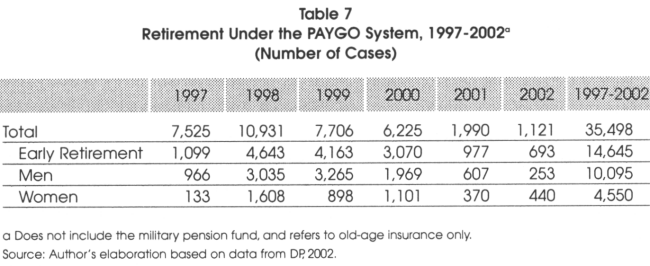
c. Post-Reform Contribution Rates
After the reform, the 5.5% employer contribution for old age, disability and death insurance was abolished and worker's salaries were raised by 4.5%30 to compensate (but see next paragraph) for the increase in the employee contribution rate, from a minimum of 6% to a standardized 12.21% (see table 1)31.
The change in post-reform contribution rates had different effects on active contributors: 7.4% of them got a reduction of their net salary between 1.2 96 and 3.7%, 47.6% virtually remained in the same situation32, 44.7% benefited from a net increase between 1.29% and 3%, and only 0.4% obtained an increase between 5% and 7 9633. Although the majority of affiliates were benefited or virtually unaffected with the change, the moral hazard problem in salary reporting with those who were negatively affected can still generate some distortions under the new system.
4.3 Valuation of the Fiscal Cost
Table 8 details total pension outlays made by the government in 1998-2003. The implementation of the reform involved expected and unexpected liabilities that affected the fiscal cost. Regarding expected liabilities: (i) pension outlays to the basic fund averaged US$ 167 million per year, while supplementary funds did it for US$ 109 million per year in 1998-2003; (ii) payments of compensatory certificates were minimum, accounting only US$1.4 million in 200334, and (iii) debt service payments related only to mandatory TB's showed an increasing burden from US$ 6.4 million in 1998 to US$ 67.7 million in 2003. A major unexpected outcome was the anticipated and additional retirement cases in contrast to initial expectations; the separation of this effect, however, was not possible due to data limitation, being its monetary valuation included in basic and supplementary funds outlays, hence shown as an expected outcome.
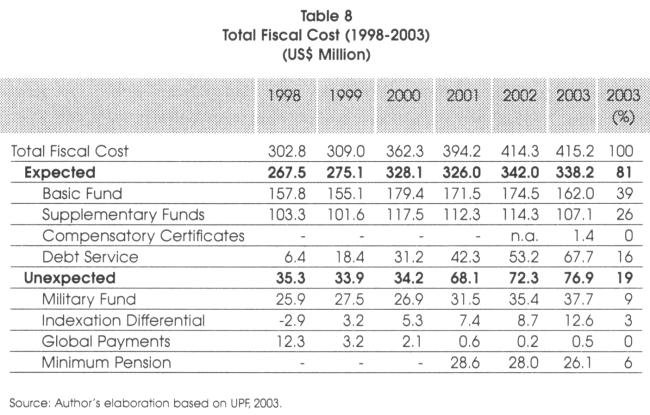
In terms of unexpected liabilities, there is to mention: (i) the inclusion of the military pension fund, averaging US$ 31 million per year; (ii) post-reform indexation additional costs from US$ 3 million in 1999 to US$13 million in 2003, being 1998 the only year of savings for the Treasury of US$ 3 million; (iii) global payments to insured workers from US$12.3 million in 1998 down to US$ 0.5 million in 2003, and (iv) minimum pension outlays, paid since 2001, averaging US$ 28 million per year in 2001-2003.
Most of the fiscal cost was due to expected liabilities as opposed to unexpected developments that introduced new commitments for the government. According to table 8, expected liabilities accounted for 81 % of the total cost as opposed to 19% of unexpected obligations, in 2003. The interpretation of data regarding expected liabilities, however, has to consider: (i) that figures shown represent the budget execution, and differ from pre-reform projections based on macroeconomic and demographic assumptions, where such difference implicitly introduces "unexpected" components to the cost, and (ii) although debt service payments were expected, they were not included in all pre-reform projections.
5. The Cost of the Transition and Public Finances
This section introduces some elements to consider regarding the pension reform and pensions policies that followed, in terms of their effects on fiscal statistics as well as expenditure levels. It is divided in three parts: (a) expansion of statistical coverage in the post-reform period; (b) accounting considerations in the post-reform public borrowing registry, and (c) linkages between the Treasury and the new pension system.
5.1 Additional Liabilities
One of the major effects of the reform on public finances refers to the scope of governmental liabilities regarding the pension system. Prior to the reform, non-financial public sector (NFPS) statistics only included pension expenditures related to the basic pension fund and two supplementary funds, as public liabilities35. After 1997, NFPS statistics started to report pension expenditures comprising all supplementary funds in addition to the military pension system, following provisions of the reform law that added these new liabilities.
Table 9 shows pension expenditures covered by the Treasury in 1990-2003. In the pre-reform period, 1990-1996, pension expenditures averaged US$ 82 million per year or 1.3% of GDP. The first 7 years of the post-reform scenario, 1997-2003, showed annual averages of US$ 387 million (4.8% of GDP). Emerging from different liabilities structures, these periods cannot be subject of direct comparison.
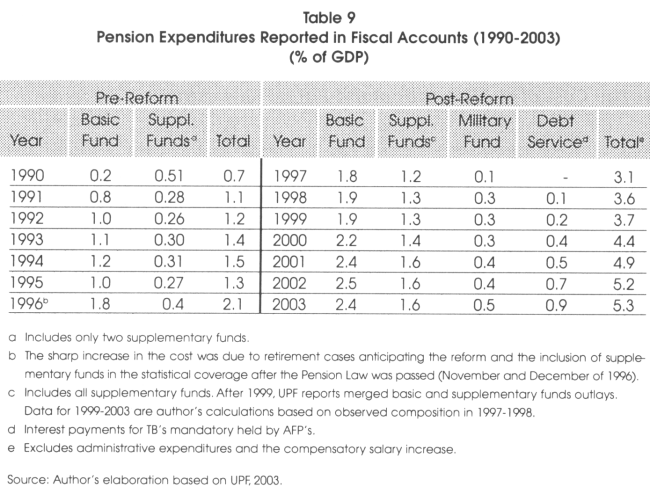
In the post-reform period, military pension fund outlays accounted for 8% of the annual fiscal cost or 0.35% of GDP, on average. Supplementary funds outlays accounted for 33% or 1.41 % of GDP. The case of debt service is also of major concern given increasing trend from 0.1% of GDP in 1998 up to 0.9 % in 2003.
As observed, the heavy contrast in pre and post-reform pension outlays is explained by the addition of liabilities, which averaged 42% of the annual fiscal cost, introducing the need to find recurrent sources of funding.
5.2 Implicit And Explicit Public Debt
Another effect on public finances has to do with the post-reform accounting registry of governmental financing resources for pension outlays, as opposed to pre-reform practices.
As Holzmann et al. (2001) argue, under a PAYGO scheme, current contributions with an implicit promise of repayment in the future out of future contributions (taxes) make the underlying debt akin to government borrowing. Under conventional accounting rules, however, fiscal accounts do not report this implicit debt36.
Certainly, the major implication of such accounting practice is the effect on the government's balance sheet. Prior to the reform, resources to finance pension outlays were reported as "above-the-line" accounts in current revenues while after the reform similar financial resources are being reported "below-the-line" as financing accounts37.
Because of accounting conventions, the overall fiscal deficit in Bolivia, for the post-reform period, has shown a comparatively deteriorated situation. As Holzmann et al. (2001) suggest, current accounting systems unjustly penalize reformer countries when International Financial Institutions' assistance, such as the case of the International Monetary Fund, is based on current deficit and conventional public debt targets, since social insurance obligations are often the longest single unreported liability for the public sector.
The "explicit debt effect" (EDE) can be thought of as the apparent deterioration on government's balance sheet due to conventional accounting practices. Table 10 shows the estimated effect on Bolivia's fiscal accounts of explicitly report pension debt, as an annual increase of 1.7 percentage points of GDP, on average, in the registry of the overall fiscal deficit for 1 998-200338. This estimate only comprises public bonds mandatory held by AFP's, which financed an average of 36% of the fiscal cost in 1998-200339.
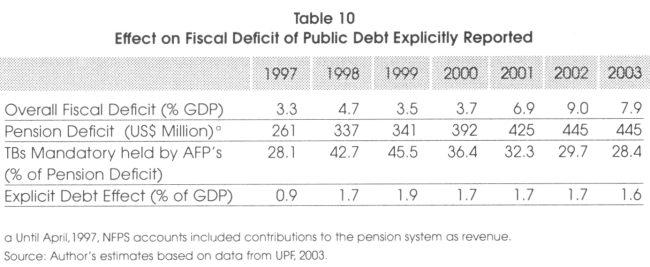
The remaining 64% of funding resources came from different sources including the sale of former assets of the old pension system that were transferred to the government, current revenues and grants, as well as concessional and commercial loans. These resources do not necessarily represent a formal reporting of a previously hidden debt but the true needs of a government with higher social security expenditures, given the increase in public liabilities after the reform.
While the EDE outcome should be included in negotiations with International Financial Institutions for financial assistance (e.g., IMF arrangements) when defining fiscal deficit and financing targets, it should be considered very carefully, however, within the central government as for budget planning. Financing requirements of the transition phase exist regardless of accounting practices for fiscal reporting. Repayments of the so-called "hidden debt" accrued under the PAYGO system will require future adjustments in the public sector within its revenue/expenditure structure to establish a sustainable trend in public finances, in order for the No-Ponzi Game condition to prevail. A Ponzi Game situation takes place when the government is financing past debt issuing new debt, on a permanent basis.
Table 11 summarizes the effect of the reform and post-reform pension policies on public finances, in 1998-2003: (i) it has caused an annual average increase of pension-related liabilities of 1.6% of GDP, and (ii) due to accounting practices, it has also led to the reporting of a higher overall fiscal deficit of 1.7 percentage point of GDP per year, on average.
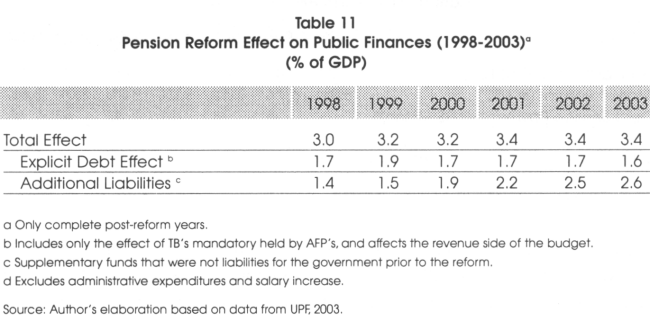
5.3 Financing The Transition Cost With Post-Reform Contributions
In addition to liabilities, the reform contemplated the transfer of assets from the pension system to the government in order to finance the transition. At December 31, 1995, the equity value of the pension system in Bolivia was approximately US$ 280 Million (INASEP, 1996). Such equity was eventually transferred to the government to help finance the transition.
In order to partially finance the transition, the government of Bolivia introduced provisions compelling AFP's to invest in TB's. This mandatory investment will take place for 15 years, starting in 1997, the implementation date of the reform.
Regulations establish that TB's that are mandatory held by AFP's cannot offer a maturity period longer than 15 years with annual negotiable coupons, expressed in US dollars or domestic currency with maintenance of value. The interest rate is variable with annual revisions based on international trends and country risk assessments; in 1997-2002, it was fixed at 8% in US$. Regulations also establish the maximum amount of such mandatory investment as the minimum between US$ 180 million and accrued contributions collected by AFP's in one year40.
Table 12 depicts the relationship between AFP's and the Treasury. Since July, 1997, the government has issued US$ 910 million in TB's, forcefully acquired by AFP's, at an annual average of US$ 140 million for 1998-2003, to partially finance the transition cost. As figures show, government indebtedness has not reached the maximum allowed of US$ 180 million per year yet; on the contrary, it has been decreasing steadily since 1999 from US$ 158 million down to US$ 124 million in 2003. Conversely, debt service payments have been increasing steadily since 1998, reaching US$ 68 million in 2003, increasing the financial burden for the Treasury.
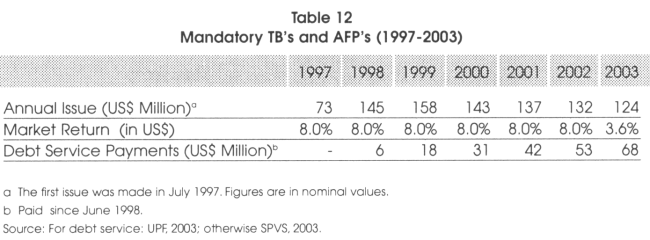
During 1997-2002, bond issuing was denominated in US$ with an 8% return. As fiscal situation started to deteriorate such return became very costly for the Treasury undermining long run fiscal sustainability (1 % of GDP in 2003). As a consequence, following the introduction of UFV in the economy, in 2003 the government started to issue TB's in domestic currency with maintenance of value -indexed to UFV's- with a 5 % nominal return, or equivalent to 3.6% in foreign currency, US$, at market rates (SPVS, 2003).
As table 13 shows, more than 50% of the Individual Capitalization Fund (ICF) portfolio is composed by public securities mandatory held by AFP's. Starting from 100% in 1997, the share of these securities has declined to 51.3% in 2003. As for public securities acquired in the secondary market, there has been a steady increase from0% in 1997 to 12.8% of the portfolio in 2003, evidencing the lack of investment opportunities in Bolivia, and placing the government into a compromising position where its decisions affect the old and new pension systems.
Given the reliance on public securities, the immediate response to the governmental action of lowering the rate of return, was a drop in the ICF portfolio market return from 7.1 % to 6.5 %, in 2002-2003 (SPVS, 2003). If such low return from public bonds continues in the future, it will have a negative impact for affiliates to the new system since the required number of contributions -working years- to reach the 70% replacement rate will be higher, or alternatively, the pension received at 65 years old will be lower.
Financial ties between the government and AFP's, have resulted is a sum-zero-game scheme between the fiscal cost of the transition on the one hand, and ICF portfolio returns and pension levels on the other hand, where higher returns and pensions imply higher fiscal costs, and vice-versa. In this regard, finding an alternative funding source for the transition cost becomes essential in order to solve this trade off.
6. Conclusions
The pension reform in Bolivia has ended up with a highly unexpected fiscal cost during the first years of the transition, surpassing initial projections. The main driving elements are related to post-reform pension policies that were introduced, including the sudden increase in retirement cases under the old system, the introduction of a minimum pension subsidy, the change in the pension indexation parameter, and the inclusion of the military pension system in the reform.
This outcome evidences the importance of the implementation phase in terms of public management when switching completely from an unfunded to a fully funded pension system. In Bolivia, several regulatory provisions have been set out during the implementation period, distorting, in some cases, the original design and causing an incremental fiscal cost for the Treasury, as in the case of early retirement policies.
However, there were also initial conditions that kept the transition cost from being higher, such as the relatively young demographic structure of insured workers within the PAYGO system (60 % of affiliates were under the age of 39 years old) and the very low coverage of the working population, 12%.
Regarding public finances, the effect of the pension reform and post-reform pension policies has been two-fold in terms of an "induced" fiscal deficit. It has increased considerably pension-related liabilities to be covered by the Treasury, demanding higher levels of funding, and due to accounting practices it has also led to the reporting of a higher fiscal deficit. Additional liabilities -comprising all supplementary funds, the military pension fund, as well as debt service payments-accounted for 42% of post-reform pension liabilities, causing an annual average increase of 1.6% of GDP, in comparison to pre-reform levels, in 1998-2003. Regarding fiscal accounting practices, the effect on fiscal accounts of explicitly report pension debt, has resulted in an annual increase of 1.7% of GDP, on average, in the registry of the overall fiscal deficit in 1998-2003.
Given the reliance of ICF portfolio on public securities, 64.1 % in 2003, the financial linkages between the government and AFP's -where AFP's are obligated to acquired up to US$ 180 million of public securities per year, until 2012- have resulted is a sum-zero-game scheme between the fiscal cost of the transition on the one hand, and ICF portfolio returns and pension levels on the other hand, where higher returns and pensions imply higher fiscal costs, and vice-versa.
Certainly, finding new sources of funding for the transition cost, especially at concessional terms, would lower the financial burden for the Treasury and would relieve AFP's of investment commitments in public securities. As for the private sector, it would improve the probabilities of developing a more dynamic domestic capital market. However, as long as the government does not increase fiscal revenues and limit expenditures expansion, it is very unlikely that mandatory investments in public debt securities by AFP's will be terminated or significantly reduced. Under this scenario, the post-reform trade-off that has emerged can diminish potential gains that led to reform the system in the first place, and fiscal equilibrium can follow an unsustainable trend.
Notes
* Former Fulbright fellow at Cornell University. Syracuse University, and the University of Pittsburgh. Currently working at the Economic Policy Advisory Office, Central Bank of Bolivia.
The author gratefully acknowledges the detailed and constructive criticism, as well as valuable editorial suggestions of earlier versions of the paper from Dr. Carmelo Mesa-Lago. He is also thankful to the Center of Latin American Studies of the University of Pittsburgh for its support, and to the staff of the Fiscal Programming Unit at the Bolivian Ministry of Finance, for sharing data. This paper reflects the scenario as of June 2004. Any error is responsibility of the author
1 The World Bank (1994) and others, however, argue that there was no solidarity in practice.
2 Although, theoretically, this could turn into an advantage, based on how the portfolio of pension funds is administrated and its performance.
3 While there is an implicit transfer from high income to low income population for administrative costs purposes -due to fixed commissions that pension managers charge-, the null income redistribution effect that is mentioned in this paragraph refers to the pension level per se, that the insured receive at the time of retirement.
4 It refers to a public system that relies on government's power of taxation, introducing an insurance component against low investment yields, economic recession, and other risks (World Bank, 1994).
5 The "unfunded" concept stands for the necessity of inter-generational transfers to finance current pensions rather than having a self- financing source, since current contributions are not set aside to pay future pension obligations (Sinha, 2000).
6 In 1987, the government separated the administration of short and long run social security -health and old-age insurance, respectively- creating FONARE (Fondo Nacional de Reservas) for administering the basic pension fund. In 1990, FOPEBA (Fondo de Pensiones Básicas) substituted FONARE (see Saavedra, 2002a, Law 924, Supreme Decree (SD) 21637, and SD 22407), For statistics and creation dates of supplementary funds, see Grandi, 2001.
7 For the history of the Social Security in Bolivia, see Mercado 1998, and Bonadona et al., 2003.
8 Following a governmental regulation, virtually all domestic financial transactions previously made in US dollars (bank deposits, public and private contractual obligations, etc.) were converted into domestic currency at a fixed exchange rate. The few exceptions were for social housing programs and related activities (see Saavedra. 2002a, SD 19249), According to Bonadona et al. (2003), in the case of the pension system (i.e. supplementary funds), approximately US$ 500 million of reserves invested in commercial time deposits were reduced down to one tenth of its value, as a consequence of this policy.
9 For a description of the political economy of the reform, see Gray-Molina et al., 1999, and Mercado, 1998. See Mesa-Lago and Muller, 2002, also for other reforms in Latin America.
10 Certainly, governments have additional financing options for the transition, such as the introduction of higher taxes and/or asset sales (privatizations). In these cases, the implicit debt does not become explicit. Partial default of pension obligations can be thought of as an option to reduce financing requirements during the transition (see Holzmann, 1997).
11 UDAPE is a decentralized agency of the Bolivian government, in charge of providing policymakers with macroeconomic impact assessments of major public policies and structural reforms.
12 Figures were converted into GDP percentages by the author.
13 The Solidarity Bonus or Bonosol (followings its Spanish acronym) is an annuity paid to citizens when reaching the age of 65 years old, currently equivalent to US$ 233. Bolivian legislation establishes that this benefit will only be paid to citizens who were 21 years of age or older on December 31, 1995. The scope of this benefit goes beyond pensioners and its introduction is related to the capitalization process rather than to the pension reform (see Baldivia, 1998). According to a recent poll published by the Superindentency of Pensions (SPVS), only 24% of all Bonosol beneficiaries are pensioners (SPVS, 2004).
14 To see an explanation of deviations from governmental projection see Grandi, 2001, Escobar 2002, and Gamboa, 2002.
15 By 2050. it is projected that the old age dependency ratio will reach 26.5% (INE. 2003). As a reference, it is expected that Europe will reach an old age dependency ratio of 50% by 2050. For more details on demographics and pensions in Europe, see Rother et al.. 2003.
16 See Bravo. 2000, for an analysis of population ageing and pension systems in Latin America
17 However, other factors also affected this outcome, such as the case of the regulatory framework, where its late introduction in 2001 caused additional delays (Escobar, 2003).
18 See Saavedra, 2002a, SD 24468, SD 25505 and SD 25620.
19 SPVS, 2002, SD 26069.
20 CC= (WY*0.7*S/25), where WY is the number of years contributed to the PAYGO system and S is the salary at October 1996, or the last salary over which the last contribution to the old system was made. The salary is indexed to the US dollar variation between the date of the reported salary and the date of the issue of the certificate. In the case of the one-time payment the formula is CC= WY*70*S/25 (SPVS, 2002, SD 26069).
21 See Saavedra, 2002b, SD 26104 and SD 26163.
22 Because of this regulation, the Pension Law was modified: initially, individual pensions were subject to annual indexation; after the introduction of the Bs. 850 minimum pension, the total pension payroll is subject to indexation. This change does not affect the cost for the Treasury, only changes the distribution of the annual indexation within pensioners.
23 The author could not get more detailed data to estimate the exact amount of insured receiving minimum pension. However, since the minimum pension in 2002 was Bs. 940, and Table 5 shows "less than Bs. 1,000", the 54% estimate is virtually correct.
24 In terms of age requirements, however, the Social Security Code contemplated some exceptions. See note (a) of Table 1.
25 SPVS 2002. Law 1732.
26 Mackenzie et al., 1993, used 65 years for men and 60 for women.
27 See Vargas del Carpio, 1996, for details on the position of the Pensioners' Confederation during the pension reform process.
28 See Saavedra, 2002b, Ministerial Resolution (MR) 1361, M.R. 026, SD 26091, and SD 26957.
29 SD 25295 and MR 1302.
30 UPF fiscal reports Include this compensatory salary increase as a pension-related expenditure. Such inclusion is distorting and overestimates post-reform pension liabilities since such increase was introduced as a substitute of a former obligation to the pension system and not to pension outlays, representing a current expenditure given the government's role of employer.
31 The minimum contribution was 2.5% for the basic fund and 3.5% for supplementary funds. Although optional, affiliation to supplementary funds became virtually mandatory when signing for the basic fund (Bonadona et al., 2003). The maximum employee contribution rate for a supplementary fund was 18.5%.
32 variation of ±0.8%.
33 Figures as of December 31,1995. The total number of active contributors was 322,577 (data from INASEP, 1996).
34 CC payments started in June 2002. The author could not get the amount paid during June-December 2002.
35 In 1995, these two funds, covering public employees in the central administration and teacher of the public system, accounted for 26% of total outlays of supplementary funds (INASEP, 1996).
36 Although similar, there are important differences between issuing bonds and pension promises. See Holzmann et al.. 2001.
37 See Valdes. 2002, chapters 8,10, and 11 for details on fiscal cost, financing options and accounting practices of the transition.
38 the year 1997 is not included in average calculations because it does not reflect a full year of new accounting practices.
39 Table 11 shows a different estimate, reflecting the share of these bonds in ICF portfolio.
40 See SPVS, 2002. SD 24469 and SD 25715.
REFERENCES
Antelo, Eduardo. 2000. "Políticas de estabilización y de reformas estructurales en Bolivia a partir de 1985". In: Quince años de reformas estructurales en Bolivia: sus impactos sobre inversión, crecimiento y equidad. Edited by Eduardo Antelo and Luis Carlos Jemio. La Paz: CEPAL/IISEC: 15-99.
Baldivia, Jose. 1998. "La capitalización." In: Las reformas estructurales en Bolivia. La Paz: Fundacion Milenio, Serie Temas de la Modernizacion: 55-121.
Barrientos, Armando. 1998. Pension Reform in Latin America. Aldershot: Ashgate Press.
Bonadona, Alberto, Gustavo Rodriguez and Jaime Duran. 2003. Antecedentes y consecuencias de la reforma de pensiones en Bolivia. La Paz: Ediciones ABC.
Bravo, Jorge. 2000. "Envejecimiento de la población y sistemas de pensiones en América Latina". Revista de la CEPAL, Santiago: CEPAL, N°. 72.
Dirección de Pensiones (DP). 2002. Database provided to the author. La Paz
Escobar, Federico. 2002. Costo de la reforma de pensiones en Bolivia. Working Paper. Dirección de Pensiones. La Paz.
____ 2003. Pension Reform in Bolivia: A Review of Approach and Experience. Background Paper for Regional Study on Social Security Reform. Washington, D.C.: Office of the Chief Economist, Latin America and Caribbean Regional Office, World Bank.
Fernandez, Maria Del Carmen. 2003. Valuación actuarial del costo fiscal Reforma al Sistema de Pensiones, Bolivia. Reporte de Consultoria. Red de Análisis Fiscal, Ministerio de Hacienda. La Paz.
Franco, Daniele. 1995. "Pension Liabilities. Their Use and Misuse in the Assessment of Fiscal Policies". European Economy-Economic Papers 110. European Commission, Directorate General for Economic and financial affairs. Economic. Brussels.
Gamboa, Ramiro. 2002. Costo fiscal de la reforma de pensiones: proyección vs. ejecución. Working Paper N°.5. Superintendencia de Pensiones, Valores y Seguros. La Paz.
Gamboa, Ramiro and Julio Humerez. 1997. Aspectos fiscales de la reforma de pensiones. Ministerio de Capitalización, Secretaria Nacional de Pensiones y Unidad de Analisis de Política Económica. La Paz.
Grandi, Evelyn. 2001. "La reforma de pensiones: su diseño y distorsiones". In: La reforma de pensiones en Bolivia: diseño original y distorsiones en su aplicación. Edited by Evelyn Grandi and Luis Carlos Jemio. Estudios de Milenio N°. 10. La Paz: Fundación Milenio: 5-56.
Gray Molina, George, Ernesto Perez de Rada, and Ernesto Yanez. 1999. La economía política de reformas institucionales en Bolivia. Working Paper R-350. Washington, D.C.: Inter American Development Bank, Office of the Chief Economist, Latin American Research Network.
Holzmann, Robert. 1997. "On the Economic Benefits and Fiscal requirements of Moving from Unfunded to Funded Pensions". In: The Future of the Welfare State. Challenges and Reforms, European Economy-Reports and Studies N °. 4: 121 -1 63.
Holzmann, R., R. Palacios and A. Zviniene. 2001. Implicit Pension Debt: Issues, Measurement and Scope in International Perspectiva. Washington, D.C.: The World Bank, Pension Reform Primer Series.
International Monetary Fund (IMF). 2003. Bolivia: Selected Issues and Statistical Appendix. Country Report N°. 03/258. Washington, D.C.: IMF.
Instituto Nacional de Estadística (INE). 2003. Bolivia: situación sociodemográfica de la población adulto mayor. La Paz: Instituto Nacional de Estadística, Serie IV Estudios Temáticos.
Instituto Nacional de Seguros de Pensiones (INASEP). 1996. Sistema de pensiones boliviano. Información estadística gestión 1995. Ministerio de Capitalización, Secretaria Nacional de Pensiones and Instituto Nacional de Seguros de Pensiones. Preliminary Information. La Paz.
Larrazabal, Erick and Victor Hugo De La Barra. 1997. Capitalizacion y pensiones. Análisis y reflexiones sobre los modelos de reforma. La Paz: Sociedad de Analisis de Políticas Públicas.
Mackenzie, G.A., Juan Amieva-Huerta and Platon Tinios. 1993. Bolivia: reforma del sistema de pensiones públicas. Washington, D.C.: Public Finances Department, International Monetary Fund.
Mercado, Marcelo. 1991. "El sistema de pensiones en Bolivia". In: Sistema de pensiones en America Latina. Diagnóstico y alternativas de reforma. Edited by Andras Uthoff and Raquel Szalachman. Santiago: CEPAL/PNUD: 27-67.
____. 1998. "La reforma del sistema de pensiones de la seguridad social". In: Las reformas estructurales en Bolivia. Serie Temas de la Modernización. La Paz: Fundación Milenio: 127-174.
Mesa-Lago, Carmelo. 2000. Estudio comparativo de los costos fiscales en la transición de ocho reformas de pensiones en América Latina. Santiago: CEPAL, Serie Financiamiento del Desarrollo N°.44.
____2001. "Structural Reforms of Social Security Pensions in Latin America: Models, Characteristics, Results and Lessons". International Social Security Review 54 (4): 67-92.
____2004. La reforma de pensiones en America Latina y su impacto en los principios de seguridad social. Santiago: CEPAL, Serie Financiamiento del Desarrollo No. 144.
Mesa-Lago, Carmelo and Fabio Bertranou. 1998. Manual de economía de la seguridad social. Montevideo: Centra Latinoamericano de Economia Humana.
Mesa-Lago, Carmelo and Katharina Muller. 2002. "The Politics of Pension Reform in Latin America". Journal of Latin American Studies 34 (3): 687-71 5.
Revilla, Ernesto. 2002. El costo de la reforma de pensiones de Bolivia. Report of Consultancy BO-0213. Inter American Development Bank. La Paz.
Rother, P.C., M. Catenaro and G. Schwab. 2003. Ageing and Pensions in the Euro Area, Survey and Projection Results. Social Protection Discussion Paper Series N°. 0307. Washington, D.C.: The World Bank.
Saavedra, Sussy. 2002a. Código de Seguridad Social. Compilación y legislación concordada de la seguridad social Boliviana. 3rd ed. La Paz: n.p.
____2002b. Sistema de reparto. Disposiciones legales del sistema de reparto, compilación concordada. 2nd ed. La Paz: n.p.
Servicio Nacional del Sistema de Reparto (SENASIR). 2003. Power Point Presentation to Bolivian Congress, December. La Paz.
Sinha, Tapen. 2000. Pension Reform in Latin America and Its Lessons for International Policymakers. Massachusetts: Kluwer Academic Publishers.
Superintendencia de Pensiones Valores y Seguros (SPVS). 2002. Compilación concordada de las normas del seguro social de largo plazo 2002. 1 St. ed. La Paz: SPVS.
____2003. Boletín Trimestral SPVS: Octubre/Diciembre. La Paz.
____2004. Estudio de Impacto Bonosol. La Paz.
Unidad de Programación Fiscal (UPF). 2003. Database from Dossier Estadístico. Viceministerio de Tesoro y Crédito Público, Ministerio de Hacienda. La Paz.
Valdes, Salvador. 2002. Políticas y mercados de pensiones. Un texto universitario para América Latina. Santiago: Imprenta de la Universidad Católica de Chile: 395-434, 505-640.
Vargas del Carpio, Oscar. 1996. Pasión y muerte de la seguridad social en Bolivia. La Paz: n.p.
von Gersdorff, Hermann. 1997. Pension Reform in Bolivia: Innovative Solutions to Common Problems. Policy Research Working Paper WPS1832. Washington, D.C.: The World Bank, Private Sector Development Cluster.
Williamson, John. 1990. "What Washington Means by Policy Reform". In: Latin American Adjustment: How Much Has Happened? Edited by John Williamson. Washington, D.C.: Institute for International Economics: 7-20.
World Bank. 1994. Averting the Old Age Crisis: Policies to Protect the Old and Promote Growth. New York: Oxford University Press.
Zviniene, Asta and Truman Packard. 2002. A Simulation of Social Security Reforms in Latin America: What Has Been Gained?. Background Paper for Regional Study on Social Security Reform. Washington, D.C.: The World Bank, Office of the Chief Economist, Latin America and Caribbean Regional Office.














